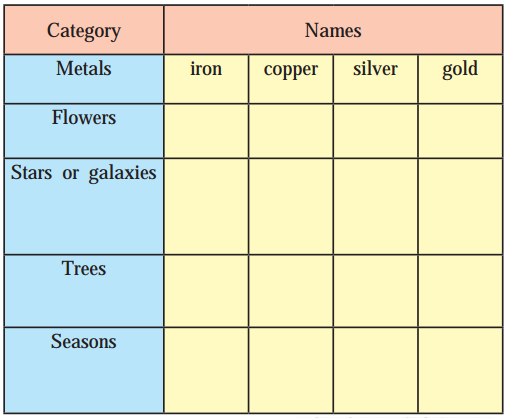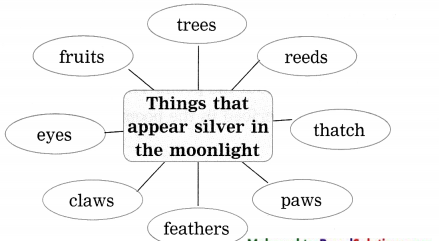Balbharti Maharashtra State Board Class 9 English Solutions My English Coursebook Chapter 4.3 Silver Notes, Textbook Exercise Important Questions and Answers.
My English Coursebook Std 9 Guide Chapter 4.3 Silver Textbook Questions and Answers
Warming up!
Chit-chat

Images
Question 1.
Imagine that your class is to be divided into groups or houses. Each house will have their own colour, symbol, dress code, sport, motto, a common room with objects of their interest and suitable furniture. Think of sets of four names for the groups. Form groups and work out the (imaginary) details for each set. Some suggestions are given here:

Answer:
| Category | Names | |||
| Metals | iron | copper | silver | gold |
| Flowers | orchid | lily | jasmine | bluebell |
| Stars or galaxies | Sirius | Conopus | Alphard | Procyon |
| Trees | sal | neem | deodar | chinar |
| Seasons | spring | summer | winter | monsoon |
Deodar House

Common room to have:
Two chairs with small round table to sit and study, two cupboards with books to read, newspapers, magazines, sofa to rest, vase in corner, pink background to the room, room freshener.
[The answers given above are for reference, students are expected to do this activity in the class.]
My English Coursebook 9th Class Solutions Chapter 4.3 Silver Additional Important Questions and Answers
Simple Factual Activities:
Question 1.
Complete the following sentences with the help of the poem:
(Answers are directly given.)
Answer:

Question 2.
Complete the following web with the names of the things that appear silver in the moonlight: (Answers are directly given.)
Answer:

Complex Factual Activities:
Question 1.
Which of the objects, animals, etc. in the poem are at rest without any motion?
Answer:
The fruits, trees, casements, thatch, kennel, dog, cote, doves, fish, reeds and the stream are the objects, animals, etc. in the poem that are at rest without any movement.
Question 2.
In which line does the word silver/silvery in the poem occur? What pattern does it show?
Answer:
The word silver/silvery occurs in the second, fourth, sixth, eighth, tenth, twelfth, and fourteenth line of the poem. The word silver/silvery is used in even numbered lines and not in the odd numbered lines in the entire poem. It adds uniformity and rhythm to the poem.

Poetic device Activities:
Question 1.
Write down the musical (rhyming) words from the poem.
Answer:
The musical (rhyming) words used in the poem are:
Question 2.
Write down the rhyming scheme of the poem.
Answer:
The rhyming scheme for the first two stanzas is aahb. The rhyme scheme of the final stanza is aabbcc.

Appreciation of Poem:
1. Title: The title of the poem is “Silver”.
2. Poet: The poet of the poem is Walter de la Mare (1873-1956).
3. Theme/Central Idea: The poem is about a moonlit night. The silvery light of the moon covers the whole earth and everything on it looks silvery. The poem stands out for its rich visual imagery.
4. Rhyme Scheme: The rhyme scheme for the first two stanzas is ‘aabb’. The rhyme scheme for the final stanza is ‘aabbcc’.
5. Figure of Speech: Simile, Personification.
6. Special Feature: This poem is very rich in its visual imagery. The poem rolls out before us like a landscape painting. A dense silence runs through the poem. The moon and the mouse are the only moving objects in the poem. The rest of the things mentioned in the poem are at rest in their silvery beauty.
7. Favourite Line: My favourite lines from the poem are:
8. Why I like the poem: I like the poem for its pleasing rhyme scheme ‘aabb’. I also like the great sound effect the poem produces when we read it aloud.
Activity:
Question 1.
If you were asked to draw a detailed picture of the scene described in the poem, what objects, animals, natural features, etc. will you show in the picture? Make a list.
Answer:
If I was asked to draw a detailed picture of the scene described in the poem, the objects, the picture are:

Question 2.
Can you think of a parallel animals, natural features, etc. that I would show in dawn/evening when everything is steeped in golden light?
Answer:
Yes, in the evening, the sun sinks below the horizon to set. As it goes lower and lower its dark – orange – crimson rays spread across the sky and the surroundings steep in gold light. It brings an awesome scenery to view.
Question 3.
The same landscape appears different at different times. What message can we draw from this?
Answer:
Two different interpretations can be made from the given sentence: